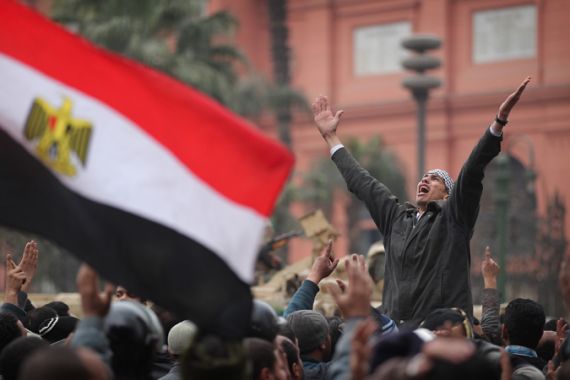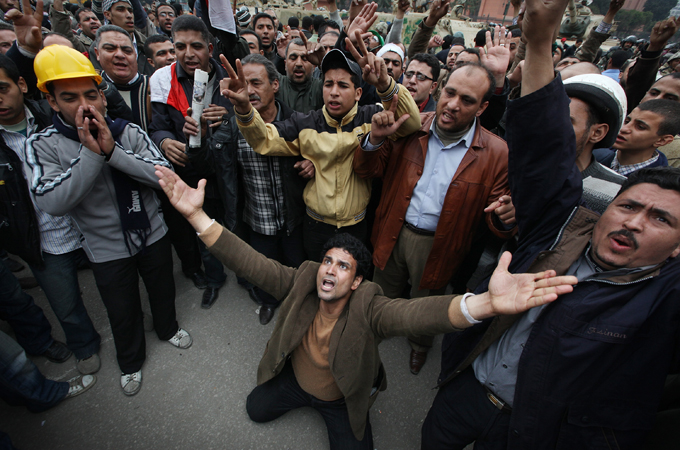Egypt’s new dawn echoes of 1919
With jubilation filling Cairo’s streets, a century-old uprising offers its passions, its lessons – and its warnings…

 |
|
A pro-democracy protester kneels as he chants and demands the resignation of President Mubarak [Getty] |
During last Tuesday’s ‘Million Man March’ and Friday’s ‘Day of Departure’ rallies, the swirling clamour of car horns, famously characteristic of Liberation Square’s soundscape, fell silent, as human cries for freedom, change and justice floated through the air.
But the scenes of a new political dawn, and the overwhelming sense of a unified national spirit are not new to Egypt’s history.
The anxious jubilation and the revolutionary vivacity that permeated the atmosphere of Egypt’s cities were reminiscent of the events that unfolded during Egypt’s popular uprising of 1919, when, for the first time in the history of the modern Egyptian state, thousands of ordinary Egyptians of all classes, men and women, young and old, Muslim and Christian, took to the streets to demand political change. In that year, after decades of British occupation, political discontent, and worsening economic conditions, the Egyptian nation rose – its people becoming an unwavering force to be reckoned with.
While the two uprisings – which both formed part of broader regional and international push for change – are vastly different historical events, they are also strikingly similar – both in the manner in which they have unfolded, and how they effectively mobilised people into action.
A look back in time
The distribution of petitions by Mohamed ElBaradei’s National Coalition for Change last year, calling for political reform, brings to mind a similar petition drive – the Tawkilat movement – which grew in the months before the 1919 uprising. Back then, Sultan Fu’ad I found a similar petition insulting – and called on the British to help him silence its advocates. When the British happily complied, banishing its Wafdist authors, they ignited a brewing revolution. So too have ElBaradei’s petitions insulted the current regime, which has clamped down heavily on activists found distributing them.
The contribution of internet and satellite TV activism in mobilising Egyptians to action in recent years are well documented as 21st century tools of revolution – but they bear parallels to the role played by theatre and music in heightening ebullient passions for change, and stirring the people’s emotions towards liberation in 1919. Just as blogging, Facebooking, and Twittering have been seen as a threat to today’s regime, popular poets, such Bayram al-Tunisi, who was exiled for his subversive writings, and musicians such as Sayyid Darwish, whose politically inflamed songs protestors passionately sang during demonstrations, were noted to be particular threats to the British and Egyptian authorities.
In both uprisings, therefore, popular forms of political mobilisation and participation gave deep expression to the nation’s economic and political discontents – and provided an accessible platform for engaging the disenfranchised. In discussing the Tawkilat movement of 1919, historian Marius Deeb argued that by politically engaging a large spectrum of the population, it functioned as a “silent rehearsal” for the ensuing uprising. Much the same can be said about the activism, in both real and virtual platforms, that today’s Egyptian protestors had been participating in over the past few years.
Failing to learn from history
Against this backdrop of immense political consciousness and involvement, the Egyptian regime today, like the British and the acquiescent Egyptian government in 1919, made a potentially fatal mistake; they went against a politically mobilised people – and insulted their intelligence. In both cases, the people had no other option but to shift their activism to the streets.
The scenes of young and articulate Egyptian women, marching in Cairo and Alexandria in recent days – chanting and leading the men in demonstrations – evoke immortalised images of the women who mobilized, marched and rallied crowds in the streets of Egypt’s cities in 1919.
Back then, even peasant women in rural regions joined in, breaking railway and telegraph lines in an attempt to disable the mechanisms of control relied on by the British and Egyptian authorities. And, as we celebrate the Christian-Muslim unity displayed in Liberation Square, it would be good to recall the story of Murqus Sergius, a Coptic priest, who in 1919 was famously carried upon the shoulders of student protestors in al-Azhar mosque, becoming the first Christian to deliver a sermon from its pulpit in its almost one-thousand year history.
But, just as the show of ‘people power’ today is reminiscent of that 1919 spirit, so too is the violence, the chaos, and the disorder that has ensued. Popular uprisings are seldom glamorous. The 1919 uprisings claimed an estimated 800 lives, as its protestors were brutally attacked by British troops and Egyptian police. The nation was paralysed as the infrastructure was damaged and demonstrations persisted.
Already an estimated 300 people have been killed in the past ten days of demonstrations, and the country is at a standstill.
This week’s clashes between anti-government protestors and government-supporting thugs, indicate that authorities, just like the British in 1919, are putting up a nasty fight, deploying draconian and scorched earth-like tactics that are as unnerving as they are appalling. The anachronistic sight of a government-hired cavalry of horses, camels and donkeys attacking peaceful protestors a few days ago is a striking metaphor for the decrepit and out-of-touch Mubarak regime.
But the parallels between the uprisings are limited. Unity on the streets of Egypt seems to have faltered somewhat in recent days, as many Egyptians, seeking a retreat to normality, asked the anti-government demonstrators to go home.
Mubarak’s last stand
Unlike the British in 1919, Mubarak can – and has – cleverly conjured people’s sympathies by playing on his “Egyptian-ness” and dramatically declaring his wish to die on Egyptian soil. In a worrying move, state-run television even played on the national insecurity of infiltration by blaming the anti-regime unrest on a foreign plot. The outcomes of this uprising had become unclear. The fault lines have blurred as definitions of what constituted true patriotism and national duty – either to go home and wait for September or struggle on for immediate results – destabilised.
It would be good to remember that after the uprisings of 1919, it took three, long, hard-fought years, for Egyptian ‘independence’ to be granted – and when that happened, it did not meet the demands of the demonstrators. While the 1919 popular uprising was a victory on some levels, the political reforms it swept in were merely cosmetic. Some, such as economist Tal’at Harb, whose statue stands not far from Liberation Square, attempted to improve the economic state of the country, and Egyptian parliamentary life seemed somewhat promising – but an authoritarian king and the implacable British still had control, and continued to stall democratic progress.
By the late 1930s, disillusionment and crushed hopes reigned supreme. The uprising of 1919 had fallen short of its objectives. Louis de Saint-Just’s frightening words that “those who make revolutions halfway only dig their own grave” perhaps rings true. What will happen next in Egypt remains to be seen; but those in Liberation Square remain determined to carry this revolution out in full.
Tellingly, as I write this, and in an expression of profound historical poignancy, one of Sayyid Darwish’s song’s “Biladi”, popular with the protestors of 1919 and adopted in 1979 as the Egyptian national anthem, roars through the Square. At this moment, one can not help but think that perhaps, almost 100 years later, the aspirations of 1919 might finally be fulfilled.
Ifdal Elsaket is a PhD candidate at the University of Sydney. Her research focuses on politics of early Egyptian Cinema.
The views expressed in this article are the author’s own and do not necessarily reflect Al Jazeera’s editorial policy.